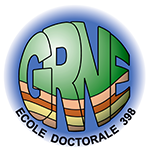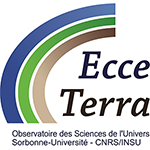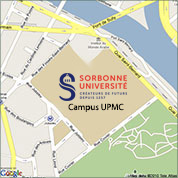Séminaire ISTeP - Lavinia Tunini
(ENS)
The central Eurasia collision zone: numerical modelling of the lithospheric structure and the present-day kinematics
The central Eurasia region is dominated by the Zagros orogen in the western sector and the Himalaya-Tibetan orogen in the eastern sector, resulted from the subduction of the Tethys oceanic lithosphere towards the NNE and the subsequent collision of the Arabia and India plates with the Eurasia plate during the Cenozoic.The lithosphere structure plays an important role in controlling the surface deformation and its propagation inside the continent. The compositional and strength heterogeneities within the lithosphere directly affect the tectonic behaviour of the region and, hence, the evolution of the orogenic systems. During my PhD I have been studying the central Eurasia collisional system by applying two different numerical approaches in order to i) characterize the lithospheric structure of the Zagros and the Himalayan-Tibetan orogens and ii) investigate the role of the lithospheric structure and rheology in the accommodation of the deformation related to the Arabia and India convergence against Eurasia. The lithospheric structure of the two orogenic systems has been characterized from the thermal, compositional and seismological viewpoint using an integrated geophysical-petrological modelling approach. The models make compatible seismic, density and thermal modelling findings, and allow quantifying the effect of mineral physics on previous results from integrated thermal models.These models have been combined with the present-day kinematics, geodetic observations and stress data to characterize the current deformation patterns in central Eurasia, by using a thin-sheet approach allowed investigating the effect of the lithospheric structure, rheology, boundary conditions, and friction coefficient on the predicted velocity and stress fields. Besides the large scale, the models offer a coherent result in regions with little or no data coverage, as in the case of the Arabia-India inter-collision zone, over large areas of Pakistan and entire Afghanistan.
29/06/2018, Salle Fourcade à 12h30
Chiffres clés (Mars 2025)
L'ISTeP comprend 131 membres dont :
Permanents (66)
- Professeurs : 17 (+2 PAST)
- Maîtres de conférence : 26
- Directeurs de recherche CNRS : 1
- Chargés de recherche CNRS : 1
- ITA : 19
Personnels non permanents (65)
- Collaborateurs bénévoles / émérites : 17
- Chaire de professeur junior : 1
- Enseignants-chercheurs contractuel : 2
- 1 MCF accueil en délégation
- ATER et Post-Docs : 9
- Doctorants : 32
- ITA-BIATSS : 3





